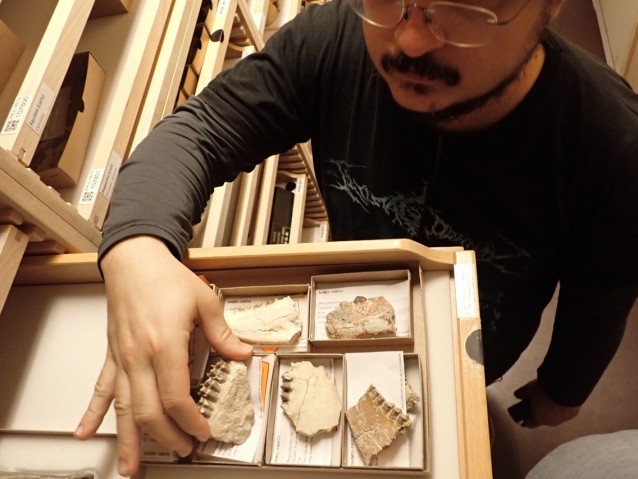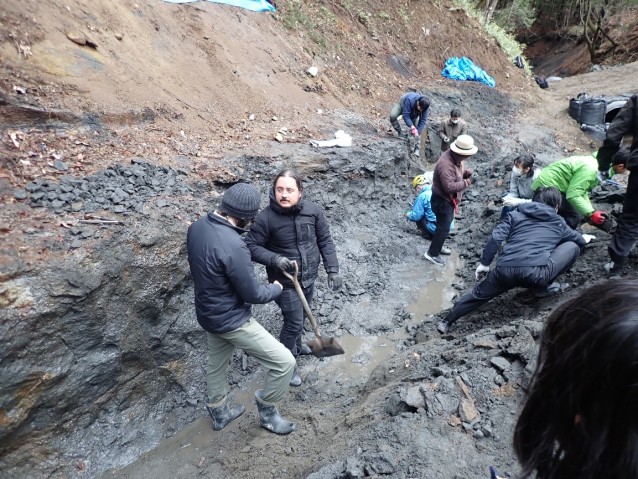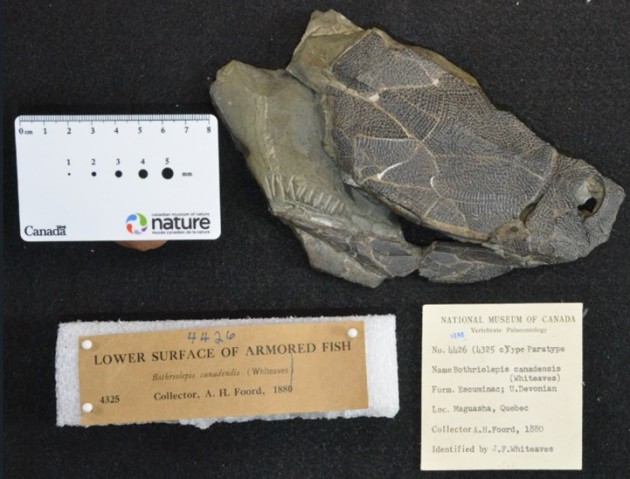Macroevolution Unit
Assistant Professor Lauren Sallan
Abstract
The Macroevolution Unit physically started in August 2022 when PI Sallan arrived on campus. The Unit grew to nine members (PI Sallan, 1 staff scientist, 1 postdoc, 3 research interns and 2 rotation students) by March 2023. Since the first Unit members arrived in Okinawa October 2022, we have pursued a number of analytical, experimental and descriptive survey projects led by unit members, some of which are in collaboration with leading overseas researchers in the US, Sweden, the UK and consortia (FishBase, AquaMaps).
These include new, Unit member-led projects on the global and regional distribution of functionally and phylogenetically distinct fishes and their key traits (Isaac Trindade-Santos), 2) the ancestral reproductive habitats of sharks and rays (RI Diala Edde), 3) the feeding evolution of early tetrapods as revealed by dental microwear experiments on Polypterus and comparison with key fossils in Canada, Sweden, and Denmark (Staff Scientist Tai Kubo and Rotation Student Johannes “Nico” Wibisana), 4) the function of convergent tooth morphologies across aquatic vertebrates (RI Samuel Fisher), 5) the functional diversity of endangered and least concern sharks in the same environments (Isaac Trindade-Santos and RI Samuel Fisher) 6) testing for presumed escalation between fishes and their invertebrate prey by tracking functional diversity during the Mesozoic Marine Revolution (Peter Reynolds). Several of these projects are in or nearing final analysis and manuscript phase (see below).
Our research efforts have also included the expansion of ongoing projects on: 1) diversification patterns and persistence across vertebrates (now led by postdoc Isaac Trindade-Santos, with Mike Alfaro at UCLA), 2) quantifying convergence and potential competition between early jawed and jawless fishes (now led by Rotation Student Nanako Okabe, with Ivan Sansom at Birmingham), 3) Patterns and drivers underlying the evolution of large filter feeders across time (with Tom Froese), 4) the physiological evolution of fishes (with Andrew Whitehead at UC Davis), 5) The effects of the end-Ordovician mass extinction on fishes (led my me). Staff Scientist Tai Kubo has continued pursuing Kakenhi-funded project on using dinosaur microwear patterns to infer evolutionary feeding patterns, and multiple Unit members have attended field work with his collaborator in Iwate related to this effort.
Since their arrival at OIST, Unit members have already published and submitted multiple papers with their Unit affiliation based on ongoing work with outside collaborators. Additional manuscripts based on work begun in the Unit are in preparation, including manuscripts led by research interns or rotation students resulting from their projects in FY 2022. PI Sallan, and other Unit members, have presented at international conferences including invited keynotes at the International Symposium on Early/Lower Vertebrates and Geological Society of America Annual Meeting. In addition, PI Sallan was invited to contribute to the workshop on Cumulative Effects and Tipping Points in Ecosystems supported by Fisheries and Oceans Canada. Finally, PI Sallan was invited to be a Board Member/Associate Editor at Proceedings of the Royal Society B, and began this position in January.
1. Staff
- Dr. Tai Kubo, Staff Scientist
- Dr. Isaac Trindade Santos, Postdoctoral Researcher
- Johannes Nicolaus Wibisana, PhD Student (Out of Field Rotation)
- Nanako Okabe, PhD Student (In Field Rotation)
- Diala Edde, Research Intern
- Peter Reynolds, Research Intern
- Samuel Fisher, Research Intern
- Makiko Ajimura, Research Unit Administrator
2. Collaborations
2.1 The Title or Name or Topic of the Collaboration
- Description: This project investigates evolutionary patterns of salinity tolerance across vertebrates using both habitat data from the fossil record and as inferred from comparative studies of organ systems.
- Type of collaboration: Joint research
- Researchers:
- Professor Andrew Whitehead (University of California)
- Dr. Stephen McCormick (USGS/University of Massachusetts)
- Professor Lauren Sallan, (OIST)
2.2 The Title or Name or Topic of the Collaboration
- Description: This project aims to construct a general ecomorphospace for early and modern fishes based on discrete but functionally-relevant traits. This allows determination of when novel trait combinations first arose, and testing for competition between distinct yet ecologically convergent groups and associations between form and habitat across disparate groups.
- Type of collaboration: Joint research
- Researchers:
- Professor Lauren Sallan, (OIST)
- Adam Asmat (OIST, Research Intern)
- Nanako Okabe (OIST, PhD Student)
- Jisoo Kim (Arizona State University, former Senior Thesis Student)
- Professor Ivan Sansom (University of Birmingham)
2.3 Gnathostome Ancestral States
- Description: This project aims to reconstruct the ancestral ecological states for gnathostomes (jawed fishes) and their relatives, using new trait databases and a new supertree for early jawed fishes.
- Type of collaboration: Joint research
- Researchers:
- Professor Lauren Sallan, (OIST)
- Carolin Grether (OIST, Research Intern)
- Winston Wilson (Imperial College London)
- Professor Martin Brazeau (Imperial College London)
2.4 Macroevolutionary Patterns of Persistent Diversity Imbalance Across Vertebrates
- Description: Here, we investigate patterns of diversity imbalance between sister clades and across the tree of life in vertebrates, and test whether imbalance is higher than reflected by change, expected from current models of diversification, and correlated with age or ecological traits.
- Type of collaboration: Joint research
- Researchers:
- Isaac Trindade Santos, (OIST)
- Professor Lauren Sallan, (OIST)
- Professor Michael Alfaro, (University of California)
- Dr. Jonathan Chang, (University of California)
2.5 Dental Microwear Texture Analysis of Early Tetrapods and Modern Analogues
- Dental microwear texture analysis (DMTA) has been widely used to reconstruct diet and jaw movement of extinct vertebrates, but not to fishes and early tetrapods. Here, we are examining patterns of dental microwear in the earliest tetrapods, their relatives, and modern analogues with similar teeth (Polypterus) in order to track the evolution of feeding during the transition to land.
- Type of collaboration: Joint research
- Researchers:
- Tai Kubo, (OIST)
- Professor Lauren Sallan, (OIST)
- Johannes “Nico” Wibisana (OIST, Rotation Student from N. Luscombe Unit)
- Ray Sallan, DDS (OIST, Science and Technology Group)
- Dr. Tetsuto Miyashita, (Canadian Museum of Nature)
- Professor Per Ahlberg, (Uppsala University)
2.6 Revealing the fauna and paleoenvironment of the Upper Cretaceous Kuji Group
- The excavation of fossils of the Kuji Group, Kuji city, Iwate prefecture, Japan. Taxonomic description of vertebrate fossils and paleoenviromental reconstruction using isotope, biomarker and pollen fossils.
- Type of collaboration: Joint research
- Researchers:
- Professor Ren Hirayama, (Waseda University)
- Tai Kubo, (OIST)
2.7 Establishing the procedure for the dental microwear texture analysis of non-mammal and non-occlusal tooth surfaces for tetrapods.
- Description: We published several papers on non-mammal DMTA, but still working on how to refine DMTA of non-mammals, especially that on non-occlusal tooth surface.
- Type of collaboration: Joint research
- Researchers:
- Lecturer Mugino O. Kubo, (University of Tokyo)
- Dr. Daniela E. Winkler, (University of Kiel)
- Tai Kubo (OIST)
2.8 Temporal Change in Functional Rarity in Marine Fish Assemblages
- Description: As the seas around Scotland warm (Celtic Sea and North Sea), fish assemblages are gaining species and individuals. In this research collaboration we focus on trends in rarity to ask how taxonomic rarity and functional rarity of marine fish species covary over time.
- Type of collaboration: Joint research
- Researchers:
- Isaac Trindade Santos, (OIST)
- Professor Anne Magurran, (University of St Andrews)
- Dr. Faye Moyes, (University of St Andrews)
2.9 sTeTra - Quantifying temporal change in traits across taxa and the globe
- Description: This global working group aims to achieve more general understanding by quantifying assemblage-level trait changes, globally distributed and across scales, taxa and biomes.
- Type of collaboration: Joint research
- Researchers:
- Isaac Trindade Santos, (OIST)
- Franziska Schrodt, (University of Nottingham)
- Ada Fontrodona Eslava, (University of St Andrews)
- Inês Martins, (University of St. Andrews)
- Brittany Pugh, (University of Nottingham)
- Annegreet Veeken, (University of Nottingham)
- Richard Field, (University of Nottingham)
- Viviana Brambilla (University of St Andrews)
- Mike McWilliam, (Hawaii Institute of Marine Biology)
- Maria Dornelas, (University of St Andrews)
- Jon Chase, (iDiv/MLU)
- Shane Blowes, (iDiv/MLU)
- Alban Sagouis, (iDiv MLU)
- Cher Chow, (University of St Andrews)
- Juan Carvajal Quintero, (iDiv/MLU)
- Roel van Klink, (iDiv MLU)
- Gergana Daskalova, (IIASA)
- Anne Bjorkman, (University of Gothenburg)
- Kyle Edwards, (University of Hawaii)
- Anne Magurran, (University of St Andrews)
- Faye Moyes, (University of St Andrews)
- Jonathan Henn, (University of Colorado Boulder)
- Joshua Madin, (Hawaii Institute of Marine Biology)
- Brian McGill, (University of Maine)
2.10 MAESTRO - Climate change effects on exploited marine communities
- Description: This research collaboration aims to build integrated models and scenarios to better predict and anticipate the mixed impacts of climate change and fishing pressure on the types of diversity in marine communities that ultimately determine their functioning. The focus here are divided in three main aspects – (1) to characterize and assess the effects of climate and fishing on the functional diversity of exploited communities during the last three decades in the Northeast Atlantic and Mediterranean Sea, (2) to forecast how exploited communities will respond to the upcoming warming until the end of this century, and (3) to investigate, for several climate change scenarios, alternative harvesting strategies targeting different species and trait groups in order to minimize the impacts of fishing on functional diversity.
- Type of collaboration: Joint research
- Researchers:
- Camille Albouy, (IFREMER, France)
- Arnaud Auber, (IFREMER, France)
- Aurore Receveur, (FRB-CESAB France)
- Grete Elisabeth Dinesen, (Technical University of Denmark)
- Kari Elsa Ellingsen (Norwegian Institute for Nature Research, Norway)
- Xavier Harley, (OFB, France)
- Jeffrey Hutchings, (Dalhousi University, Canada)
- David Keith, (Fisheries and Oceans Canada)
- Kristin Kleisner, (Environmental Defense Fund, USA)
- Pascal Laffargue, (IFREMER, France)
- Fabien Leprieur, (Université de Montpellier, France)
- Matthew McLEAN, (Dalhousie University, Canada)
- Katherine Mills, (Gulf of Maine Research Institute, USA)
- David Mouillot, (Université de Montpellier, France)
- Marta Rufino, (Instituto Português do Mar e da Atmosfera, Portugal)
- Nancy Shackell, (Bedford Institute of Oceanography, Canada)
- Eric Thiebaut, (Station Biologique de Roscoff, Sorbone Université, France)
- Girt Van Hoey, (Flanders Research Institute of Agriculture, Belgium)
- Rita Vasconcelos, (Instituto Português do Mar e da Atmosfera, Portugal)
- Antony Viera, (Comité Régional des Pêches Maritimes et des Elevages Marins, France)
- Isaac Trindade Santos, (OIST)
2.11 Global trait biogeography of common and rare marine fish across Climatic Zones
- Description: Here we ask how the functional traits of bony and cartilaginous marine fish differ between common and rare species, and how these patterns vary across climatic zones.
- Type of collaboration: Joint research
- Researchers:
- Professor Anne Magurran, (University of St Andrews, Scotland)
- Dr. Faye Moyes, (University of St Andrews, Scotland)
- Isaac Trindade Santos, (OIST)
2.12 Diverging taxonomic and functional beta diversity among different spatial scales in Neotropical fish assemblages
- Description: This research collaboration aimed to test the effect of scale on the patterns of taxonomic and functional beta diversity of freshwater fish communities in the Neotropics.
- Type of collaboration: Joint research
- Researchers:
- Isaac Trindade-Santos, (OIST)
- Kátia Meirelles Felizola Freire, (Federal University of Sergipe, Brazil)
- Laura H. Antão, (University of Helsinki, Finland)
- Haley Arnold, (University of St Andrews, Scotland)
- Cristian S. Dambros, (Federal University of Santa Maria, Brazil)
- Anne E. Magurran1, (University of St Andrews, Scotland)
- Pablo A. Martinez, (Federal University of Sergipe, Brazil)
- Faye Moyes, (University of St Andrews, Scotland)
- Maria Palomares, (University of British Columbia, Canada)
- Lauren Sallan, (OIST)
- Sidney F. Gouveia, (Federal University of Sergipe, Brazil)
2.13 Applying Knowledge of “Ecological Tipping Points” to Environmental Decision Making.
- Description: This was a interdisciplinary workshop hosted online by the Canadian Center for Evidence-Based Conservation at Carleton University and supported by Fisheries and Oceans Canada. This resulted in a joint review paper on evidence for tipping points at multiple scales in the fossil record and modern ecosystems.
- Type of collaboration: Workshop and Joint review paper
- Researchers:
- Meagan Harper (Carleton University)
- Trina Rytwinski (Carleton University)
- Irina Creed (University of Toronto)
- Brian Helmuth (Northeastern University)
- John Smol (Queen’s University)
- Joseph Bennett (Carleton University)
- Dalal Hanna (Carleton University)
- Leonardo Saravia (CADIC-CONICET)
- Juan Rocha (Royal Swedish Academy of Sciences)
- Charlotte Carrier-Belleau (Universite Laval)
- Aubrey Foulk (Northeastern University)
- Anan Hernandez Martinez De La Riva (Carleton University)
- Courtney Robichaud (Carleton University)
- Professor Lauren Sallan (OIST)
- Angeli Sahdra (University of Ottawa)
- Steven Cooke (Carleton University).
2.14 Evolution of Filter Feeders
- Description: This project attempts to reconstruct the convergent evolution of trait complexes enabling filter feeding in large aquatic vertebrates, and determine the effects of the existence of such ecomorphologies on ecosystem structure.
- Type of collaboration: Joint Research
- Researchers:
- Professor Lauren Sallan (OIST)
- Professor Tom Froese (OIST)
3. Activities and Findings
3.1 Subsection Title If Necessary
4. Publications
4.1 Journals
- Winkler, D. E., Kubo, T., Kubo, M.O., Kaiser, T.M., and Tütken, T. First application of dental microwear texture analysis to infer theropod feeding ecology. doi: 10.1111/pala.12632 (2022)
- Winkler, D. E., Iijima, M., Blob, R.W., Kubo, T. and Kubo, M.O. Controlled feeding experiments with juvenile alligators reveal microscopic dental wear texture patterns associated with hard-object feeding. Frontiers in Ecology and Evolution doi: 10.3389/fevo.2022.957725 (2022)
- Moyes, F., I. Trindade-Santos, and A. E. Magurran. Temporal change in functional rarity in marine fish assemblages. Proc. R. Soc. B. 290: 20222273.20222273. doi: 10.1098/rspb.2022.2273 (2023)
- Martins, I. S., F. Schrodt, S. A. Blowes, A. E. Bates, A. D. Bjorkman, V. Brambilla, J. Carvajal-Quintero, C. F. Y. Chow, G. N. Daskalova, K. Edwards, N. Eisenhauer, R. Field, A. Fontrodona-Eslava, J. J. Henn, R. van Klink, J. S. Madin, A. E. Magurran, M. McWilliam, F. Moyes, B. Pugh, A. Sagouis, I. Trindade-Santos, B. McGill, J. M. Chase, and M. Dornelas. 2023. Widespread reductions in body size are paired with stable assemblage biomass. bioRxiv:2023.2002.2003.526822.
4.2 Books and other one-time publications
Nothing to report
4.3 Oral and Poster Presentations
- Kubo, T. Dental microwear texture analysis and its application to dinosaurs. Canadian Museum of Nature seminar, Ottawa, Canada, January 25th (2023).
- Sallan, L., Kim, J., and Sansom, I. Quantifying Convergence and Innovation in Fossil Fish Ecomorphology. International Paleontological Congress, Khon Kaen, Thailand. November 7-11, 2022.
- Sallan, L. The Role of Habitat Transitions in the Evolution of Fishes (and Vice Versa) (Invited). GSA Connects, Denver, CO (Online), October 10, 2022.
- Sime, J. and Sallan, L. Exploring the Role of Transitions Between Fresh and Salt Water in the Macroevolution of Ray-Finned Fishes (Actinopterygii). GSA Connects, Denver, CO (Online), October 10, 2022.
- Whitehead, A., Sallan, L., McCormick, S. International Congress on the Biology of Fish, Montpellier, France, June 28-July 1, 2022
- Sallan, L. Tips from TED: Communicating natural science research to large public audiences (invited). Japan SciComm Forum, October 21, 2022.
- Sallan, L. Panel Discussion, 3rd Tohoku University-OIST 3rd Joint Workshop on Biodiversity, October 24-26.
5. Intellectual Property Rights and Other Specific Achievements
Nothing to report
6. Meetings and Events
- TED2022, Vancouver, Canada (April 2022)
- International Symposium on Early and Lower Vertebrates, Valencia, Spain (Remote; July 2022)
- Geological Society of America Connects Annual Meeting, Denver, CO (Remote; October 2022)
- Tipping Points Workshop, Carleton University Canada (Remote; October and December 2022)
- Japan SciComm Forum, OIST (Online, October 2022)
- 3rd Tohoku University-OIST 3rd Joint Workshop on Biodiversity, (October 24-26.)
- International Palaeontological Congress, Khon Kaen, Thailand (November 2022)
- OIST Science Café, Tokyo (December 2022)
- OIST Science Challenge (March 2023)
7. Other
- Service: Professor Sallan Appointed Board Member and Associate Editor, Proceedings of the Royal Society B
- Peer Reviews, Nature, Science, Nature Communications, Proceedings B, Royal Society Open Science, Biological Reviews, Palaeontology, Palevol, National Science Center Poland, Swiss National Science Foundation.
- OIST Outreach Talks: PI Sallan Presented at OIST Science Café, Tokyo (December 2022) and OIST Science Challenge (March 2023)
- Other Outreach: Consulted on Early Vertebrates and Mass Extinction for “Surviving Earth” Documentary, LoudMinds Productions (UK).











